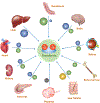The biology of mammalian multi-copper ferroxidases
- PMID: 35167013
- PMCID: PMC9376197
- DOI: 10.1007/s10534-022-00370-z
The biology of mammalian multi-copper ferroxidases
Abstract
The mammalian multicopper ferroxidases (MCFs) ceruloplasmin (CP), hephaestin (HEPH) and zyklopen (ZP) comprise a family of conserved enzymes that are essential for body iron homeostasis. Each of these enzymes contains six biosynthetically incorporated copper atoms which act as intermediate electron acceptors, and the oxidation of iron is associated with the four electron reduction of dioxygen to generate two water molecules. CP occurs in both a secreted and GPI-linked (membrane-bound) form, while HEPH and ZP each contain a single C-terminal transmembrane domain. These enzymes function to ensure the efficient oxidation of iron so that it can be effectively released from tissues via the iron export protein ferroportin and subsequently bound to the iron carrier protein transferrin in the blood. CP is particularly important in facilitating iron release from the liver and central nervous system, HEPH is the major MCF in the small intestine and is critical for dietary iron absorption, and ZP is important for normal hair development. CP and HEPH (and possibly ZP) function in multiple tissues. These proteins also play other (non-iron-related) physiological roles, but many of these are ill-defined. In addition to disrupting iron homeostasis, MCF dysfunction perturbs neurological and immune function, alters cancer susceptibility, and causes hair loss, but, despite their importance, how MCFs co-ordinately maintain body iron homeostasis and perform other functions remains incompletely understood.
Keywords: Ceruloplasmin; Copper; Ferroxidase; Hephaestin; Iron; Zyklopen.
© 2022. The Author(s), under exclusive licence to Springer Nature B.V.
Figures


References
Publication types
MeSH terms
Substances
Grants and funding
LinkOut - more resources
Full Text Sources
Other Literature Sources
Miscellaneous

